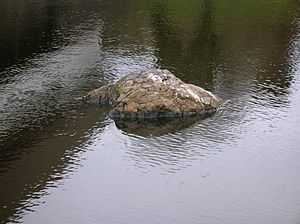Grannie stone facts for kids
The Grannie Stone is a really old and mysterious rock found in the River Irvine in Irvine, North Ayrshire, Scotland. You can see it clearly when the water level is low. People aren't sure if it's the last piece of an ancient stone circle or just a huge rock left behind by a glacier from the Ice Age!
The Mysterious Grannie Stone
The Grannie Stone is one of Irvine's most interesting old puzzles. This big boulder might be a "glacial erratic." That's a fancy name for a rock that was carried by a giant glacier during the Ice Age and then dropped when the ice melted. Or, it could be the only stone left from a much larger stone circle that once stood here.
Many other stones were removed by blasting in 1897 and 1899. This happened after a small dam, called a weir, was built in 1895. But people protested, and luckily, this one stone was saved! The weir made the water deeper, so the stone became less easy to see. The Grannie Stone was also jokingly called 'Paddy's Milestone' because some thought it looked a bit like the island of Ailsa Craig.
What's in a Name?
Nobody is completely sure where the name "Grannie Stone" came from. Some ideas suggest it might be linked to old gods like Apollo Grannicus, a Roman-British sun god, or Grainaig, a Celtic sea goddess. One old story says that Grianaig, a goddess, was turned into a grey boulder. Sadly, the true story behind the name has been lost over time. There's even another "Granny stone" in Gourock, but that one is on dry land!
What Was It Used For?
It's possible the Grannie Stone is just a natural rock left by a glacier, with no special ancient meaning. It's not listed by the RCAHMS, which keeps track of important historical sites. It also doesn't show up on the first old maps of Irvine.
There was a crossing point nearby called the Puddlie Doodlie ford, or Puddleford. Some people think its name might come from "pas de Dieu," meaning "holy steps." These could have been stepping stones used by monks from the Carmelite Priory to get to church. Some of these stepping stones might have come from a group of stones that were later removed, with the Grannie Stone being the last one left. Horses were not allowed to use the Puddleford after 1836 to protect access to a public well. Stepping stones are still marked on maps as late as 1860.
One local historian, Strawhorn, believed the stone was part of a stone circle. He also thought some of the other stones were used to build the Puddleford steps.
The Grannie Stone once played a special part in the Carters Society's Marymass celebration. The Carters used to circle the stone twice on their way to the Irvine Moor. This was said to celebrate William Wallace crossing the River Irvine at this spot in 1297. He was supposedly on his way to attack the English army. This suggests the stone was on dry land or in shallower water back then, as the weir built in 1895 made the water deeper.
The story from 1297 is about an English army, led by Sir Henry Percy, sent to Irvine. They wanted to stop an uprising against the king, John Balliol. The Scottish army, led by Robert Bruce, decided to surrender without a fight. The story about William Wallace's brave action here is mostly a legend.
Many people still believe that the River Irvine has changed its path. They think the area under the Saint Inan's church cemetery was once a green field with a stone circle, and the Grannie Stone was the biggest part of it. The other stones are said to have been washed away by the river or broken up later. An old photo from the 1890s shows the stone further from the river bank than it is today.
Images for kids






